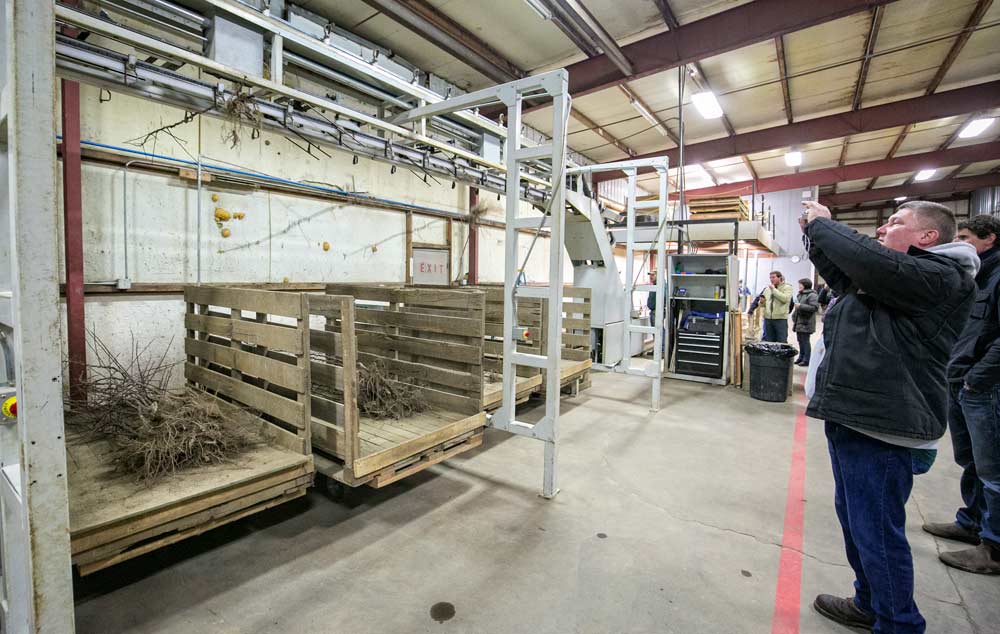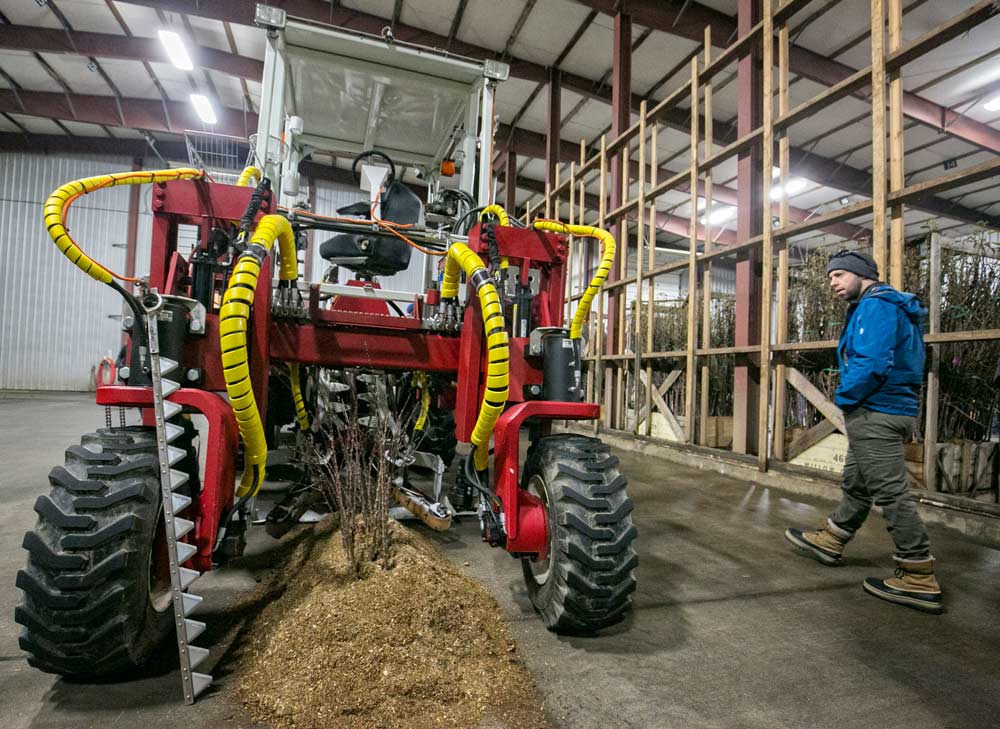
Attendees watch a custom automated rootstock bin loader during a tour at Willow Drive Nursery’s Ephrata, Washington, facility during the 2017 International Fruit Tree Association 60th annual conference in February. (TJ Mullinax/Good Fruit Grower)
Automated packing lines are not just for apples anymore — they are increasingly used for young apple trees at nurseries.
Rising labor costs and worker shortages are squeezing the labor-intensive business of producing new fruit trees, so many nursery owners are considering mechanization opportunities.
Willow Drive Nursery in Ephrata, Washington, showed off its tree grading and packing line to attendees on the International Fruit Tree Association tour in February.
It can run 66 trees a minute, which are scanned by a grading software on a conveyor belt and then dropped into the correct bin according to size.
The packing line can do 28,000 trees a day, nursery co-owner and sales manager Jim Adams told the tour group. By hand, workers can do about 16,000.
That’s a significant advantage for the nursery, which grew about 1.7 million trees for 2017 delivery.
The sorting line is still a “fair weather machine” that struggles with some of the more branchy varieties, Adams said. Those must still be sorted by hand to prevent damage.
The nursery is considering additional options for automating their warehouses in the future, but the biggest labor cost comes in the fields during the summer.
“During the summer, we have over 200 employees, and everything has to be done by human hands,” Adams said.
Harvest also presents a labor crunch because they like to get all the trees and rootstocks out of the ground in just a few weeks in late fall before the ground freezes.
Key to that effort is their custom-built rootstock harvesting machine, which was on display for the IFTA tour.
Rootstocks are grown in stool beds, which the nursery uses to cultivate suckers that grow off a mother tree. It’s a fragile system, so driving the harvester requires an experienced, steady hand, Adams said.
“If you go too fast you risk pulling up the mother plants. You can do a lot of damage in a hurry,” he said. But even at a cautious pace, they can harvest their entire crop of about 5 million rootstocks in eight to 10 days, Adams said.

Roger Mennell looks over one of Willow Drive Nursery’s custom-made machines for automating some tasks during the 2017 International Fruit Tree Association 60th annual conference in February. This machine digs and cuts rootstocks from rows and deposits them into bins located at the back of the machine for use at Willow Drive’s Ephrata, Washington, nursery. (TJ Mullinax/Good Fruit Grower)
The new harvester is the result of years of modifications to an older model, which Willow Drive purchased from an outside engineer, that didn’t live up to its promise.
Now that they’ve found a design that works, the old one is being rebuilt to match the new one. And with two harvesters, the nursery is now prepared to expand its stool beds, Adams said.
Building your own equipment is common in the nursery industry, said John Baugher, vice president of Adams County Nursery in Aspers, Pennsylvania.
“Because it’s such a small number of us doing this, no company is going to go out and build something to satisfy this need; it wouldn’t be profitable. So we end up building our own machines or adapting something from the landscaping industry,” said Baugher, who is also the nursery production manager.
He’s been experimenting with an automated platform to carry workers through the nursery — not to lift them up like orchard harvesters, but to lower them down to the level of baby trees.
“We do lots of tree manipulation at different times and different heights as the tree grows. If people could ride on a platform instead of bending over or stooping over or crawling, I’m sure that would work, if we could get people comfortable,” Baugher said.
Finding a comfortable position for people to ride the machine in, however, has been challenging, but they are continuing to refine the prototype.
Several years ago, Adams County Nursery installed the same type of grading equipment as Willow Drive, and that is working out well, Baugher said. He’s keeping an eye out for other opportunities to automate as well, he said.
And nurseries that have not invested in mechanization yet are also keeping a close eye on the possibilities.
“We are watching and observing equipment that is developing in certain aspects of the operation. Some other companies have added some equipment to help with the labor force, and we are looking hard at if it makes sense,” said Todd Snyder, president of C&O Nursery in Wenatchee, Washington. “In many instances the ‘speed’ of the operation doesn’t improve, but the operation is completed with less manpower.”
That’s appealing in light of rising costs, including a new minimum wage in Washington, since the nursery’s workforce can jump from about 25 full-time employees to as many as 200 during parts of the season.
“Planting, growing, care, digging, grading, storing, shipping and follow-up all take people. This means that increasing labor costs, including benefits, seem to continually go up and eat at the business costs in a higher proportion to other parts of the business,” Snyder said in an email.
Of course, most of the labor that goes into tree production can’t readily be automated or mechanized.
“We touch every tree multiple times during the six- to-eight month growing season, putting in stakes and tying trees,” Baugher said. “It’s very difficult to automate because it’s so labor intensive.”
To ensure that it has a sufficient labor supply, Adams Country Nursery is using its first H-2A contract this year, Baugher said.
They’ve used the federal guest worker program in the past for the orchard side of the business and are optimistic that it will benefit the nursery as well. Adams County Nursery grows its baby trees in Delaware and needs 30 to 45 workers in season, he said.
The H-2A contract offers more security, as does custom equipment that makes workers far more efficient, but nurseries will always need lots of hand labor.
“We’ve been trying to innovate and reduce labor costs for 20, 30 years,” Adams said. “If we could speed things up, we would, but a lot of times there is no replacement for human hands.” •
– by Kate Prengaman






Leave A Comment